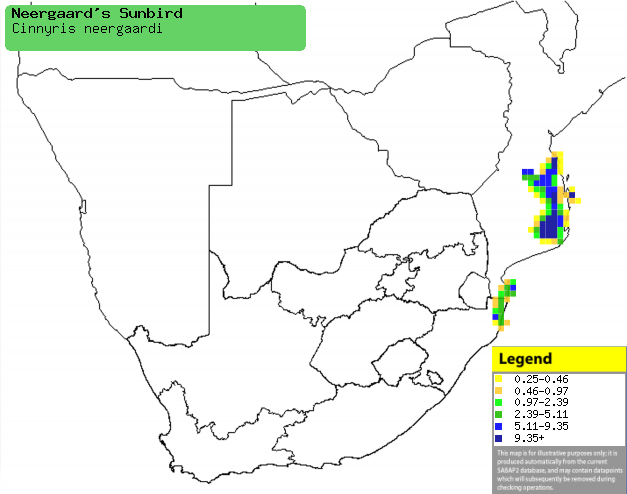|
Cinnyris neergaardi (Neergaard's
sunbird)
[= Nectarinia neergaardi]
Bloukruissuikerbekkie [Afrikaans]; Neergaard-honingzuiger
[Dutch]; Souimanga de Neergaard [French]; Neergaards nektarvogel [German];
Beija-flor de Neergaard [Portuguese]
Life
> Eukaryotes >
Opisthokonta
> Metazoa (animals) >
Bilateria >
Deuterostomia > Chordata >
Craniata > Vertebrata (vertebrates) > Gnathostomata (jawed
vertebrates) > Teleostomi (teleost fish) > Osteichthyes (bony fish) > Class:
Sarcopterygii (lobe-finned
fish) > Stegocephalia (terrestrial
vertebrates) > Tetrapoda
(four-legged vertebrates) > Reptiliomorpha > Amniota >
Reptilia (reptiles) >
Romeriida > Diapsida > Archosauromorpha > Archosauria >
Dinosauria
(dinosaurs) > Saurischia > Theropoda (bipedal predatory dinosaurs) >
Coelurosauria > Maniraptora > Aves
(birds) >
Order: Passeriformes > Family: Nectariniidae
Distribution and habitat
Endemic to southern Africa, where it is generally uncommon
in south-eastern Mozambique, with a localised population in the far south of the
country marginally extending into KwaZulu-Natal. In inland areas it generally
prefers mixed, Acacia and the undergrowth of miombo (Brachystegia)
woodland along streams, while its southernmost population is most common in
coastal sand forest.
|
 |
|
Distribution of Neergaard's sunbird in southern Africa,
based on statistical smoothing of the records from first SA Bird Atlas
Project (©
Animal Demography unit, University of
Cape Town; smoothing by Birgit Erni and Francesca Little). Colours range
from dark blue (most common) through to yellow (least common).
See here for the latest distribution
from the SABAP2. |
Food
It mainly feeds on the nectar of trees, creepers, epiphytes
and mistletoes but in summer, when nectar is scarce, it may supplement its diet
with arthropods and juice sucked from fruit. The following food items have been recorded
in its diet:
- Plants
- nectar
- Cadaba natalensis (Green-leaved wormbush)
- Rhoicissus digitata (Baboon grape)
- mistletoes
- Plicocepalus kalachariensis
- Tieghemia bolusii (Elm mistletoe)
- Capparis sepiara (Hedge caper-bush)
- Capparis tomentosa (Woolly caper-bush)
- Stropanthus gerrardii (Spider flower poison-rope)
- Acacia xanthophloea (Fever-tree acacia)
- Aloe
- Schotia capitata (Dwarf boer-bean)
- Mimusops obovata (Bush milkwood)
- Syzygium cordatum (Waterberry)
- juice sucked from fruit
- Rhipsalis baccifera (Mistletoe cactus)
- Invertebrates
- insects
-
spiders
- hard-shelled snails (Trachycystis ariel)
Breeding
- The nest is built by the female, consisting of an oval-shaped structure
with a side entrance concealed by a hanging flap of material. In sand forest
it is often built of old-man's-beard lichen (Usnea) and lined with
seed pods of Spider flower poison-rope (Stropanthus gerrardii), but
in other areas it can be made of tendrils, bark and leaves bound with spider
web. It is typically placed in a tree about 4-6 metres above ground, often
concealed by a dense clump of old-man's beard lichen or the hanging roots of
an orchid.
- It lays about 2 creamy white eggs speckled with brown, grey and mauve,
usually in the period from September-January
- The chicks are fed by both parents but mainly the female, on a diet of
arthropods and snails.
Threats
Near-threatened largely due to forest destruction,
which has caused its range to contract; it at least has a few reasonably sized
populations in protected areas.
References
-
Hockey PAR, Dean WRJ and Ryan PG 2005. Roberts
- Birds of southern Africa, VIIth ed. The Trustees of the John Voelcker
Bird Book Fund, Cape Town.
|
